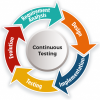Related Content
 |
The Premortem: Planning for Failure While a postmortem, or retrospective, is done after a project is completed, a premortem is done before the project starts as a way to imagine that the project failed and to explore what went wrong. You list every possible thing that can go wrong, then devise solutions to the most probable risks—before you need them. |
|
 |
Creating a Cohesive Culture in a Distributed Organization When organizations are distributed across multiple locations, it brings questions about how much each location should have a unique identity relative to the larger company. While a theme of “we are one” is common, it’s better to embrace the differences and work toward being a cohesive group that celebrates diversity. |
|
 |
4 Takeaways from Agile + DevOps East 2018 With a week full of sessions, tutorials, training classes, and events, the Agile + DevOps East software conference had plenty of takeaways. Here are four highlights, including discussions about agile estimation, finding your ideal job, some challenges to advancing test automation, and leading self-organizing teams. |
|
 |
Can Your Project Succeed without Your Sponsor On Board? Project managers are tasked by sponsoring executives to complete projects successfully and provide timely communication if barriers arise. But what should a project manager do if the sponsors are the biggest barrier? If you can’t get the answers you need, is it a good idea to make your best guess and proceed? |
|
 |
Agile and DevOps Bring the Focus Back on Quality As companies move to agile and DevOps, silos are coming down and there is more interaction and collaboration among teams. Quality is also becoming everyone's responsibility for the entire software development lifecycle. Quality is more than just testing: Consider a quality value stream along the overall value chain. |
|
 |
Frameworks Are an Agile Leader's Best Friend With a framework in place, engineers can stop worrying about everything that framework does for them. Your team can focus on solving your business problems instead of building yet another solution to an old problem that's been solved before. Look around and identify the mistakes your team is making over and over. |
|
 |
Continuous Testing Is Not Automation Many people confuse continuous testing with test automation. That makes sense, because you cannot do continuous testing without automated tests. But it is much more. Continuous testing has a higher-level maturity that could require a totally different way of working—but it also gives a faster path to production. |
|
 |
3 Steps to Transformational Leadership for Business Agility Building your agile organization only starts with developing software in an agile way. The next step is transforming your business with a customer-focused embrace of agile across the entire enterprise. Managers who want a truly agile organization must lead with focus, steer from the edges, and change the system. |








